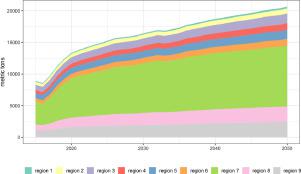Resources, Conservation and Recycling ( IF 13.2 ) Pub Date : 2021-02-17 , DOI: 10.1016/j.resconrec.2021.105465 Kaixin Huang , Matthew J. Eckelman

|
Retrospective studies such as the National Air Toxics Assessment have focused on modeling hazardous air pollutant (HAP) concentrations and exposures in the near past; however, future projections of HAPs emissions are relatively unexplored compared to those for greenhouse gases or criteria pollutants, and HAPs are typically not included in energy systems optimization or integrated assessment modeling. In this study, we demonstrate a method that harnesses sector-based emissions data from the US environmentally extended input-output (USEEIO) model and scenario results from the National Energy Modeling System (NEMS) to project HAPs emissions from industrial sectors in United States, disaggregated to 9 regions. The results show that most HAPs have higher projected emissions in 2050 compared to the baseline year when assuming constant emissions intensities per unit of economic output, but lower emissions when trend values for pollution control and technology improvements are incorporated. Regional and temporal patterns are diverse among the 237 HAPs considered. Using formaldehyde as a prominent example, the oil and gas sector is the largest national contributor (49%-77%) to future formaldehyde emissions across scenarios. Overall, this method enables projections of industrial HAPs emissions, aligned with official NEMS scenarios, that can be used in assessments of future air quality and potential health impacts from HAPs.
中文翻译:

使用国家能源建模系统(NEMS)估算美国的有害空气污染物的未来工业排放量
诸如国家空气毒理学评估之类的回顾性研究集中于对危险空气污染物(HAP)浓度和近期暴露进行建模。但是,与温室气体或标准污染物的排放相比,HAP排放的未来预测还相对未开发,并且HAP通常不包括在能源系统优化或综合评估模型中。在这项研究中,我们演示了一种方法,该方法可以利用来自美国环境扩展投入产出(USEEIO)模型的基于部门的排放数据以及来自国家能源建模系统(NEMS)的情景结果来预测美国工业部门的HAP排放,分为9个区域。结果表明,如果假设每单位经济产出的排放强度恒定,那么大多数HAP在2050年的排放量将比基准年高,而在结合污染控制和技术改进趋势值的情况下,其排放量则更低。在所考虑的237个HAP中,区域和时间模式各不相同。以甲醛为例,石油和天然气行业是情景中未来甲醛排放量最大的国家贡献者(49%-77%)。总体而言,此方法可以对工业HAP排放进行预测,并与官方NEMS情景保持一致,可用于评估未来空气质量和HAP对健康的潜在影响。在所考虑的237个HAP中,区域和时间模式各不相同。以甲醛为例,石油和天然气行业是情景中未来甲醛排放量最大的国家贡献者(49%-77%)。总体而言,此方法可以对工业HAP排放进行预测,并与官方NEMS情景保持一致,可用于评估未来空气质量和HAP对健康的潜在影响。在所考虑的237个HAP中,区域和时间模式各不相同。以甲醛为例,石油和天然气行业是情景中未来甲醛排放量最大的国家贡献者(49%-77%)。总体而言,此方法可以对工业HAP排放进行预测,并与官方NEMS情景保持一致,可用于评估未来空气质量和HAP对健康的潜在影响。



























 京公网安备 11010802027423号
京公网安备 11010802027423号